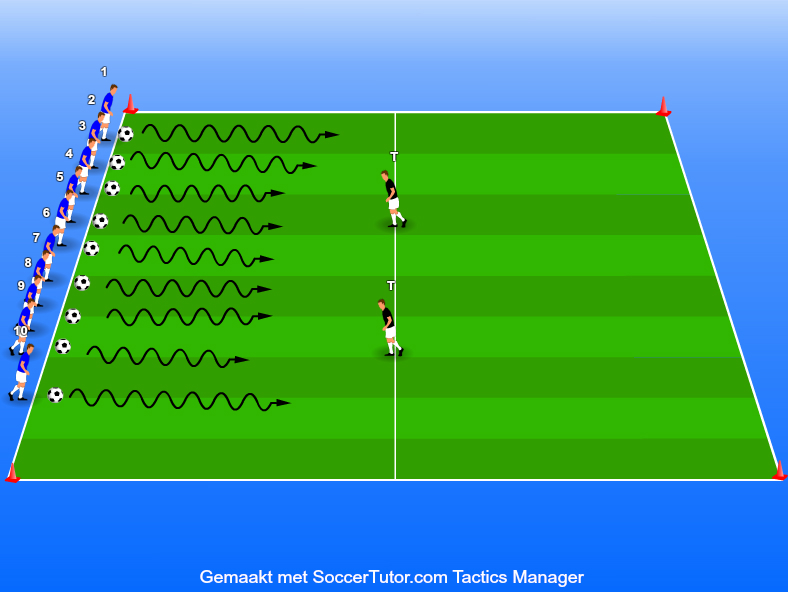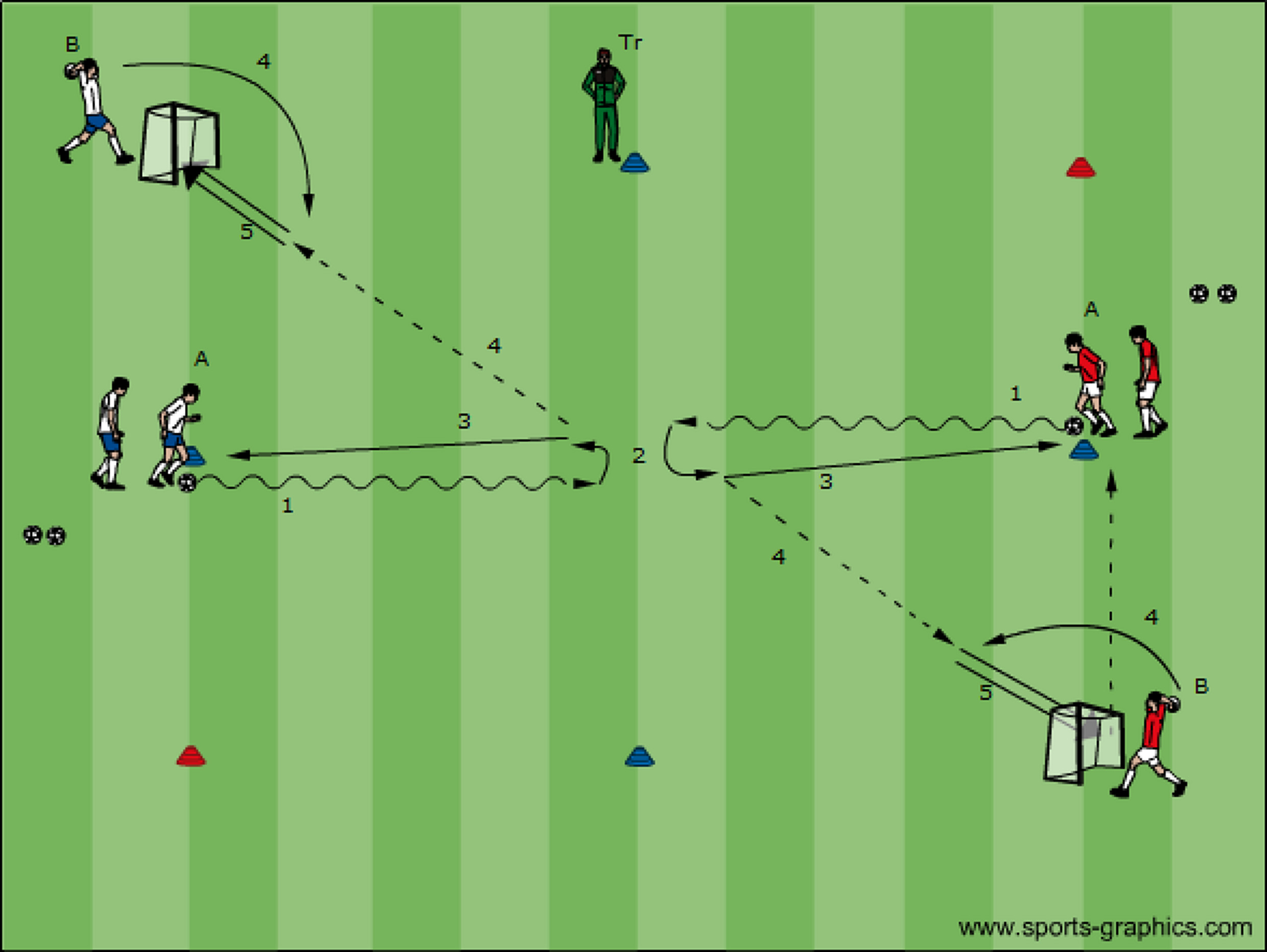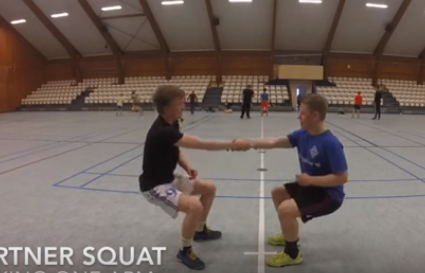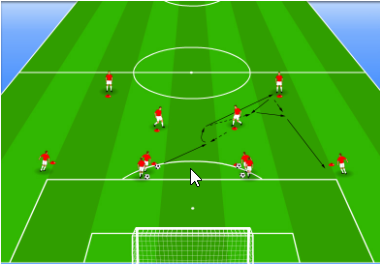Soccer drills for technique warming-up
The players line up in a circle, ideally 6 to 8 players per circle. Per circle you have only one ball.
Execution:
One player passes the ball to another player, runs after the ball towards the player he plays in â€" the second player receives the ball and plays it again to another player from the circle, he too runs after the ball again towards the player he just played in. This keeps repeating itself.
Quality:
- Passes must be clear and accurate.
- The passes are played over the ground, keep the ball low!
- Just after the pass, the players accelerate (short sprint)
- The players call out the name of the player they want to play in
- All players are constantly on their toes, not flat footed, this is to improve handling speed.
Progression:
- You can make the game more difficult by applying one hit
- You can play with two balls
- Split your team into three teams of four
- 1 ball per team
Implementation:
- Players play the ball around within their team of four in the marked area
Quality:
- Players keep moving constantly, with many tempo changes to find space.
- Each team must try to maintain a diamond shape
- Players should all communicate with teammates, asking for the ball and calling out the name of the player by the person passing the ball
- Passes should arrive well, in space or at the feet.
- Players may not touch each other, nor may the balls touch each other.
- This drill requires great attentiveness from the players.
Progression:
- Limit the number of touches to one or two.
- Add a passive defender who can defend every ball.
- Add a defender who may conquer the ball.
For this fun and interactive football warming up you let the players make a circle around you, about 15 metres away from you. You stand in the middle of the circle.
Execution:
- The starting point of the players is their spot in the circle, they stay “jogging†on their spot.
- Call: “Inside†and all players sprint towards you up to a meter or two away from you. Then they turn around and quickly sprint back to their spot keeping moving.
- Call out “outside†and all players sprint away from you until you call out “backâ€, then everyone returns to their starting position in the circle.
Quality:
- Make sure players are not standing on their flat feet, but always on their toes.
- Players should sweat profusely after this drill.
Progression:
- You can add different variations: sit-ups, push-ups, jump up, knees up at base position, sprint to the right or left while maintaining the circle shape.
- Make groups of 2 for this passing warm-up, with 1 ball per group of 2.
- The players with the ball line up on the sideline. The other players stand opposite, about 6 meters from the player with ball.
Execution:
- Player A dribbles forward, while player B jogs backwards across the field.
- As the players jog across the field, player A passes the ball to B, who passes it back to A, until they reach the opposite sideline.
- The roles reverse when the players reach the other side of the field. Player A then runs backwards to the line where they started.
Quality:
- Have passes alternate from right foot to left foot.
- Players should try to hit the ball once, only if it is really necessary can they hit it twice.
- Focus on quality over speed, it's not a race.
- Don't forget to encourage successes!
Progress:
- Play the ball on the thigh, bring the ball under control and volley back to partner.
- Play the ball on the chest, bring the ball under control and volley back to partner.
- Play the ball on the head, head the ball back to partner.
- For this warm up, set out an area of 30 by 40 yards.
- Give each player a number.
Execution:
Players pass in numerical order: # 1 to # 2 to # 3 etc. as they move through the plotted area.
Quality:
- Use 2-3 balls to increase speed and awareness.
- Make sure players are moving through the entire area and not just staying close to the players they are supposed to pass to.
- Players should all ask for the ball when it is their turn and call out the name of the player they are going to play in themselves.
Advancement:
- Have players perform special actions when making a pass, for example:
- Play the ball in the run. The receiving player must accelerate.
- The odd numbers may only hit once, the even numbers 2 times. Alternate this.

Drafting:
- Field of 10m by 10m
- 1 or 2 magic trees (trainers) in the middle.
- 1 ball per player.
- Task 1:
- Players walk from one side of the magic forest to the other.
- Without losing the ball.
- Task 2:
- Players walk from one side of the magic forest to the other.
- Without losing the ball.
- But watch out; the magic trees have woken up.
- And moving through the forest.
- Task 3:
- Players walk from one side of the forest to the other.
- Without losing the ball.
- But beware; the magic trees have woken up by a storm and are moving through the forest.
- But there are also branches and leaves everywhere.

This exercise can be used for each category in the warm-up.
- Both players A lead the ball to the middle pawn where they perform a cutting move and then play the ball to the next player.
- After the pass, the player walks diagonally to player B who throws in the ball on which player A heads the ball in.
- The heading player then takes the ball and stands behind goal,
- The other player joins the group that has to perform the movement
- Make a square with pylons in which butter cheese and eggs can be played
- form two groups
- use 6 jackets, 3 yellow and 3 green
- Play butter cheese and eggs with the jackets
- Hold each others right arm en bend through the knees in a squat position
- Do the same with the left arm

- Players face each other briefly in pairs.
- On the ground between the two players lies a ball.
- Trainer gives the commands:
- Head,
- chin,
- knees,
- feet,
- ears,
- BALL!
- On the command BALL! the players must try to get the ball as fast as possible.
- On the other commands they tap the corresponding body part
- You can use this exercise if you want to work in positions with a defensive triangle.
- You can apply variations where necessary and also change the distances.
- This exercise has been given several times with youth teams as well as with the first teams.
- As you can see in the picture we work on 2 sides.
- Approximately the space from the 16m to the center line.
- First player plays the ball diagonally, player B turns with the ball and plays it to C who performs a 1/2 with B. C plays the ball deep on D. It connects to the other group.
- When A is past the zone the other group leaves.
- Passing on A-B-C-D.
- You can also replace player D by a goalkeeper.
- You can do enough variations in this warm-up exercise. An extra 1/2 for player D. Or player B who moves on the pass of C and responds to D. And so on.
- Let the exercise run for about 4 minutes before inserting a variation.
- Always emphasize the forward rotation of B.
- Take care of a short passing and a short acceleration after the pass at the end of the warming up.

- The players line up in a circle,
- Ideal is 6 to 8 players per circle.
- Per circle you only have one ball.
EXECUTION:
- A player plays the ball to another player, chasing the ball towards the player he is playing.
- The second player receives the ball and plays it back to another player in the circle,
- He, too, will chase the ball towards the player he has just played in.
- This keeps repeating itself.
QUALITY:
- Passes must be clear and accurate.
- The passes are played over the ground, keep the ball low!
- Just after the pass the players accelerate (short sprint)
- Players call the name of the player they want to play in
- All players constantly stand on their toes, not on flat feet, to improve the speed of action.
PROGRESS:
- You can make the game more difficult by hitting once.
- You can play with two balls
- Player 1, who has given the pass, should try to tap the player who has played the pass (player 2) before playing the ball to player 3, etc.







